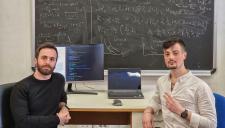It will be provided by HERA, the scientific project investigating the reionization of the Universe in which the Scuola Normale Superiore is participating as a founder/partner.
PISA, 31 January, 2023. In an article published in The Astrophysical Journal, the international team of cosmologists from the Hydrogen Epoch of Reionization Array (HERA), who, through an array of 350 radio telescopes located in the Karoo desert of South Africa seek to measure the composition of stars and galaxies of the primordial Universe, reported that it has doubled the sensitivity of the instrument, which was already the most sensitive radio telescope in the world dedicated to the exploration of this unique epoch in the history of the Universe.
In particular, HERA seeks to measure the radiation from neutral hydrogen that fills the space between the first galaxies and determine at which point it stopped emitting or absorbing radio waves as it became ionized. The Scuola Normale Superiore is part of this scientific endeavour thanks to Andrei Mesinger, associate professor of astronomy and astrophysics, winner in 2015 of the ERC Starting Grant, "An Illumination of the Dark Ages" (AIDA), for developing state-of-the-art numerical models to study the morphology and timescales of cosmic reionization. Professor Mesinger and his research group have provided the theoretical foundations of the HERA programme as a part of the AIDA project.
The article in The Astrophysical Journal refers to preliminary observations during 94 nights in 2017 - 2018, using only forty antennas - the first phase of the Array. The theoretical interpretation, guided by Dr. Yuxiang Qin, ex-postdoc of Scuola Normale Superiore, has shown that the first galaxies were more efficient in X-ray production in comparison to local ones, thus heating the intergalactic medium to higher temperatures than implied by the HERA phase 1 upper limits. This provides the first observational proof that supports theories in which the first galaxies, and in particular their X-ray binary stars, had less complex elements (metals) compared with their present-day descendants, allowing them to be more luminous.
When the remaining radio antennae of the array are online and calibrated, ideally this Autumn, the team hopes to build a 3D map of neutral and ionized bubbles of hydrogen as they evolve from about 200 million years to about 1 billion years after the Big Bang. The map could provide us with even more details about how the first stars and galaxies differ from the ones we see today around us, as well as the properties of the early Universe as a whole.













